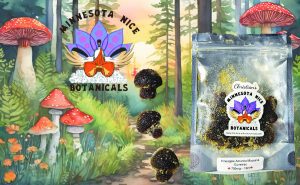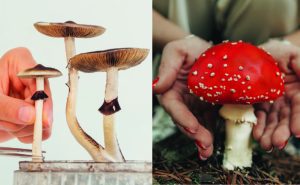What is the genus Amanita and why is it one of the most interesting mushrooms species in the world? The genus Amanita contains agarics, which are a type of mushroom fungus. Amanita is a genus of fungi that includes some of the most fascinating fungi on Earth. The genus Amanita contains several hundred agaric fungi. These diverse fungi include the most valuable and the most highly prized edible species. Some of these fungi are responsible for mushroom poisonings, including amanitas which contain the poisonous Amanita phalloides. Amanitin is the toxin found in poisonous mushrooms. Here we will discuss the genus Amanita and its toxicity. We will also provide information on identifying to avoid poisoning from this fungi genus.
Different types of genus Amanita mushrooms
Some of the more common Amanita species include:
Amanita pantherina: This mushroom is commonly found in northern climates and can grow up to six inches in diameter. Its cap is blue-green in tone and has wavy purple edges. Gills start white and gradually turn a pinkish violet. This mushroom, if ingested, can lead to severe stomach pain and even cardiac arrest. For detailed information on Amanita pantherina visit First Nature to learn more about Amanita pantherina.
Amanita muscaria: The Amanita muscaria, or fly agaric, is a brightly coloured mushroom commonly found in the vicinity of deciduous forests and fields. It has a yellowish-orange centre to its olive-brown cap, and its white gills eventually turn a greenish-violet colour as it matures. These mushrooms contain psychoactive compounds that, when ingested, can cause vivid hallucinations and a high level of euphoria. Read our article “What Are Amanita Muscaria Mushrooms?” to learn more.
Amanita phalloides: With its introduction to North America, this mushroom has become a common mushroom in certain regions. It is found primarily in Europe and Asia. It has a white cap with a brown spot in the middle and black gills that fade into olive green. Ingestion of Amanita phalloides can lead to life-threatening diarrhoea and vomiting. The Amanita phalloides has been named the “death cap” and for good reason. This mushroom can be very dangerous if consumed. Read more about the death cap mushroom Amanita phalloides on First Natures website.
3 Amanita identification tips
1.
You can find some of the world’s most famous and stunning mushrooms in the genus Amanita. Species of the genus Amanita can get identified by their pale, detachable gills, white spore prints, a universal veil that frequently forms a volva or other distinctive features on the stem, and dry caps. You can find a ring around the stem of many Amanita species, and the caps of many of these mushrooms have warts or patches.
2.
While the amanita genus is more accessible to identify than the gilled mushroom family, there are some frustrating and challenging spots within the genus, especially with the white species. The genus has been well-studied (for some examples, see the list of citations below), and many species get recognised by a small number of readily observable, consistent characteristics.
Look for a ring higher up the stem; many amanitas have a partial veil that leaves a ring on the stem, though some, like those in the Amanita vaginata species group, do not. Make a mental note of the ring’s durability and any stains or discolourations it may acquire over time. Both significant features are the cap’s hue and any pronounced striations along its edge. You can see the universal veil on the cap in the form of warts or patches. Even though some Amanita species have distinct aromas, you should not try to identify them based on their taste since the flavour is not the only characteristic that can differentiate two species in the Amanita genus.
This video by StoneAgeMan gives some terrific insights into the Amanita muscaria mushroom .
3.
Since amanitas can be challenging to identify, we recommend gathering as many specimens as possible at varying stages of development. Extraction of certain Amanita species from the ground can be a time-consuming process. If your mushroom has a universal veil made of powder, you’ll want to be extra cautious during this step. Before leaving, you should scoop up as much fine soil as possible from the surrounding area. Some amanitas’ stem bases can reach depths several inches below the surface. You can distinguish amanita species from one another based on their smell, but you should never risk your health by eating a mystery mushroom.
You can find a variety of books and tools related to mushroom foraging and identification on Amazon. Check out all these neat books and tools!
Edibility
The edibility of amanitas varies widely. The deadly A. virosa and the edible A. caesarea belong to this genus. While many people enjoy eating amanitas, others wisely steer clear of the entire genus to avoid the risk of a potentially fatal mistake. Many mushrooms are edible, but mycologists (those who study mushrooms) advise against hunting for them because of the high probability of coming across poisonous varieties.
Mushroom Wonderland’s You Tube Channel has some incredible videos about foraging for mushrooms in the pacific northwest United States.
Much information about the edibility of Amanita fungi species needs to be improved, another factor contributing to the caution needed when consuming mushrooms. However, this practice remains widespread in cultures where edible mushrooms are locally cultivated and serve as main market products during the growing season. The Amanita zambiana and Amanita basii fungi of central Africa, the Amanita caesarea and Amanita jacksonii species of Mexico, the Amanita rubescens and “Blusher” fungi of Europe are all examples of these edible fungi. Amanitas are dangerous fungi to eat unless you are an expert on the species and its close relatives in your region, as there is a wide range of variation within the genus. Make sure to do your research before consuming any mushroom species.
Effects of eating Amanita mushrooms
Some of the most psychoactive mushrooms in the world are Amanita. Amanitin, Amanita phalloides DNA and peptide A and B, ibotenic acid, and psilocybin are some psychoactive compounds in these fungi. There is a wide range of potential physiological and psychological effects from exposure to these chemicals.
Users have also report increased energy and euphoria, hallucinations, and distorted sensory perception (including unusual colour perception). Some people also say anxiety, fear, and paranoia. Some people find the psychedelic effects of Amanita mushrooms to be unpleasant or even harmful, while others can’t get enough of them. Remember that everyone reacts differently to these substances, so reading up on them first is always a good idea.
We encourage you to read this article by Max Savage Levenson, “I Tried Amanita Muscaria, The Delta 8 Of Mushrooms, Here’s How It Went”.
Symptoms of amanita poisoning
Poisoning from Amanita mushrooms can result in various symptoms, but gastrointestinal issues such as vomiting, diarrhoea, and abdominal pain are the most common. Convulsions, weakened muscles, and even death are all possible outcomes of these side effects worsening. Flu-like symptoms, changes in blood pressure, hallucinations, and mental decline are also possible side effects. You must immediately seek medical attention, contact poison control and dial 911 if you over-consume Amanita mushrooms and develop any worrying symptoms. If you need additional information related to mushroom poisoning please visit the National Library of Medicine website for more information.
Nate
Nate is a longtime contributor to many cannabis, hemp and psychedelic related websites including Amanita Info. His passions include small business, the psychedelic industry and its positive role in mental health. When he isn't writing he enjoys working out and watching the history channel.






